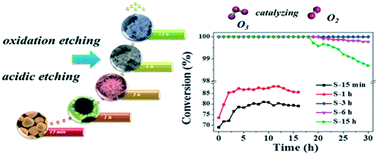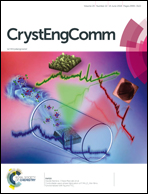Facile solution synthesis of Cu2O–CuO–Cu(OH)2 hierarchical nanostructures for effective catalytic ozone decomposition†
Abstract
Various Cu-based composites for catalytic ozone decomposition have been synthesized by the reduction of Cu2+ using NH2OH·HCl in an aqueous solution without the addition of any extra etching agent. A Cu2O–CuO heterogeneous composite with many nanometer-sized CuO nanoplates distributed on the Cu2O surface as well as Cu(OH)2 nanowires was fabricated, and the structural evolution process was explored. The mechanism for the structure's formation can be attributed to the synergistic reaction of oxidation etching and acidic etching. It was found that the surface morphology and chemical composition of the nanostructures play important roles in catalyzing ozone decomposition. The Cu2O–CuO–Cu(OH)2 hierarchical nanostructure exhibits a 100% ozone (20 ppm O3 per air) decomposition efficiency at room temperature after 30 h of continuous operation, showing high stability. In addition, the hierarchical nanostructure also shows high moisture resistance, and the ozone conversion can still be above 80% at high relative humidity levels (ca. 90%) after a 16 h test. The excellent performance can be attributed to the delocalized holes speculated by EPR spectroscopy, which may facilitate the necessary electron transfer between intermediate oxygen anions and the catalytic surface.



 Please wait while we load your content...
Please wait while we load your content...